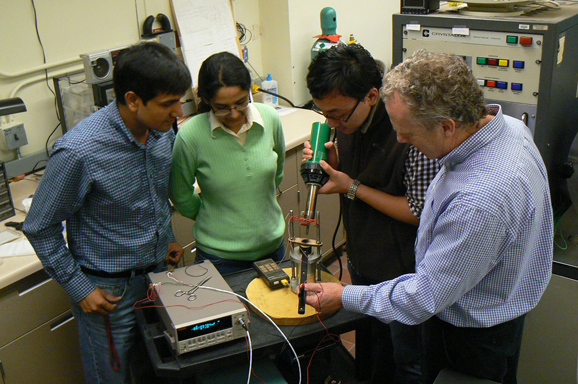From 1824, engineers have learned to use the phase change between liquid water and gas water to generate electricity. Now, American scientists are beginning to explore the use of metal alloys called multiferroic materials to undergo "phase transitions" to directly convert heat into electricity.

Prof. Richard James (first from right) and the other three members of his research team are experimenting.
A team led by Richard James of the University of Minnesota hopes to use the naturally occurring phase transitions in multiferroic materials instead of water to generate electricity. He said that boiling and condensing water requires huge pressure vessels and Heat exchangers.
Multiferroic materials generally have ferromagnetic, ferroelectric, or iron elastic properties. The natural manifestation of iron elasticity is the phase change, that is, a crystal structure can suddenly be deformed into another, and this phase change is called martensitic transformation. The James team developed mathematical theory of martensitic phase transitions and found a way to systematically coordinate the composition of multiferroic materials to open and close the phase transitions.
In general, the metal will turn on magnetic, but hysteresis will hinder it. James said: “The key is to manipulate the composition of the alloy so that the two crystal structures that undergo martensitic transformation can coexist perfectly, so that the hysteresis of the phase transition will be significantly reduced and the reversibility will be greatly increased. We need to really see the perfect interface within the coordination alloy."
To this end, James and the University of Antwerp, Belgium Electron Microscopy Laboratory for Materials Science (because of the use of electron microscopy for the study of phase transitions) Nick Scrawwers teamed up to experiment with the “members†of the Hessler alloy family. The Hessler alloy was first made by Konrad Hessler, a 19th-century German mining engineer. Although the metals that make up the alloy are not magnetic, they have amazing magnetism and martensitic transformation.
The James team changed the basic composition of the Hesler alloy Ni2MnSn and turned it into Ni45Co5Mn40Sn10. James said: "Ni45Co5Mn40Sn10 is an amazing alloy, the low-temperature phase is not magnetic, but the high-temperature phase has a strong magnetic, like the phase change of water in the power plant. If you use a small coil around the alloy, and through the phase When it is heated, the magnetic mutation will generate current in the coil. In this process, the alloy will absorb some latent heat and convert the heat directly into electricity."
This technology will have a profound impact, and people are expected to no longer need to equip the power plant with huge pressure vessels, drainage facilities for transporting and heating water, and heat exchangers. Moreover, this principle can also be applied to many heat sources on the Earth with small temperature differences. James said: "We can even use the ocean surface and a temperature difference of several hundred meters to generate electricity."
Scientists have also developed a thin film version of this device that can be used in computers to convert waste heat from computers into electricity to charge batteries. James stressed that this is just a few of the many applications of martensitic phase transitions for energy conversion. The two phases have different physical properties in addition to magnetic properties and can be used to generate electricity using heat.
The results of this study were published in the latest issue of the scientific journal Advanced Energy Materials.
WPC Decking Co., Ltd. , http://www.hswpcdecking.com